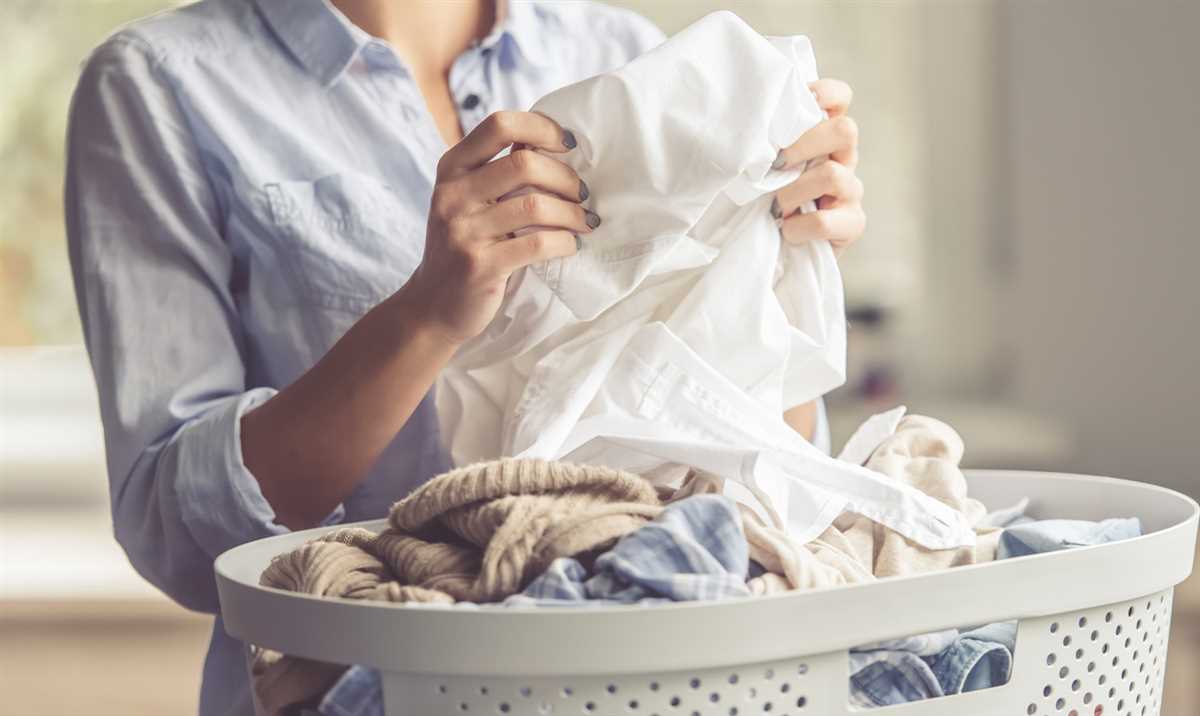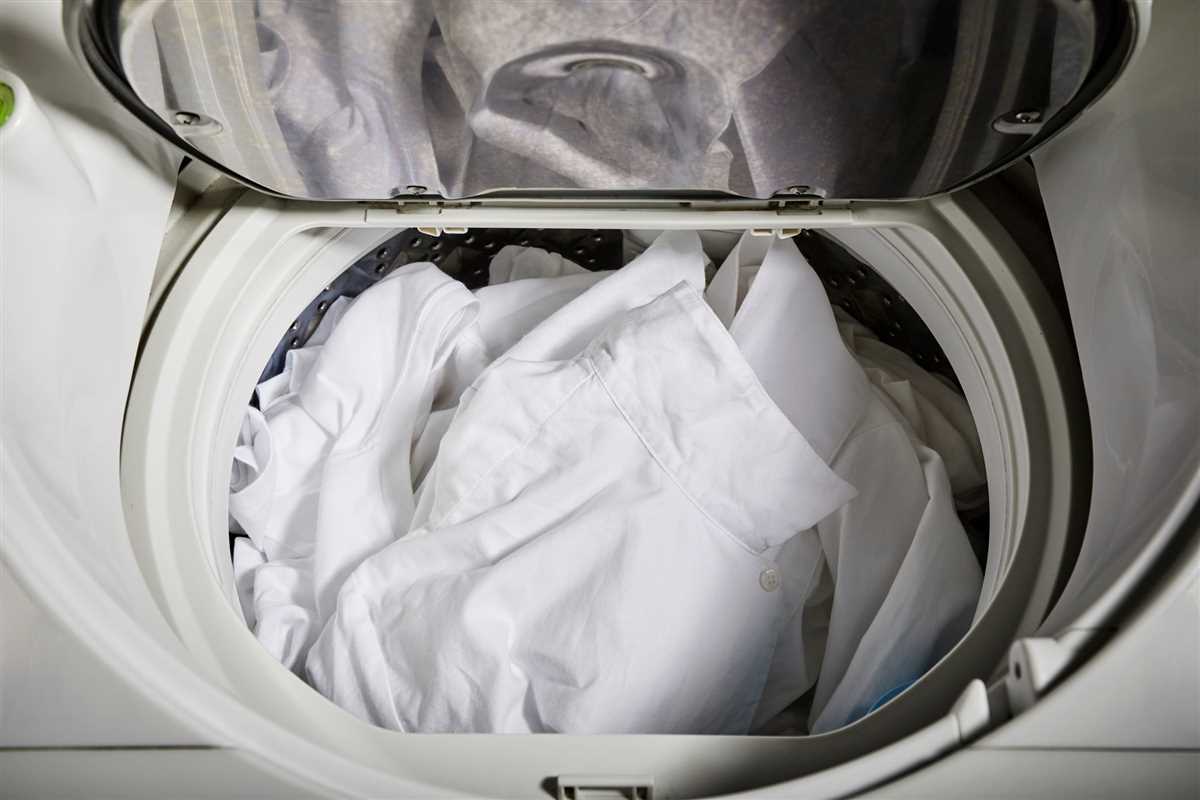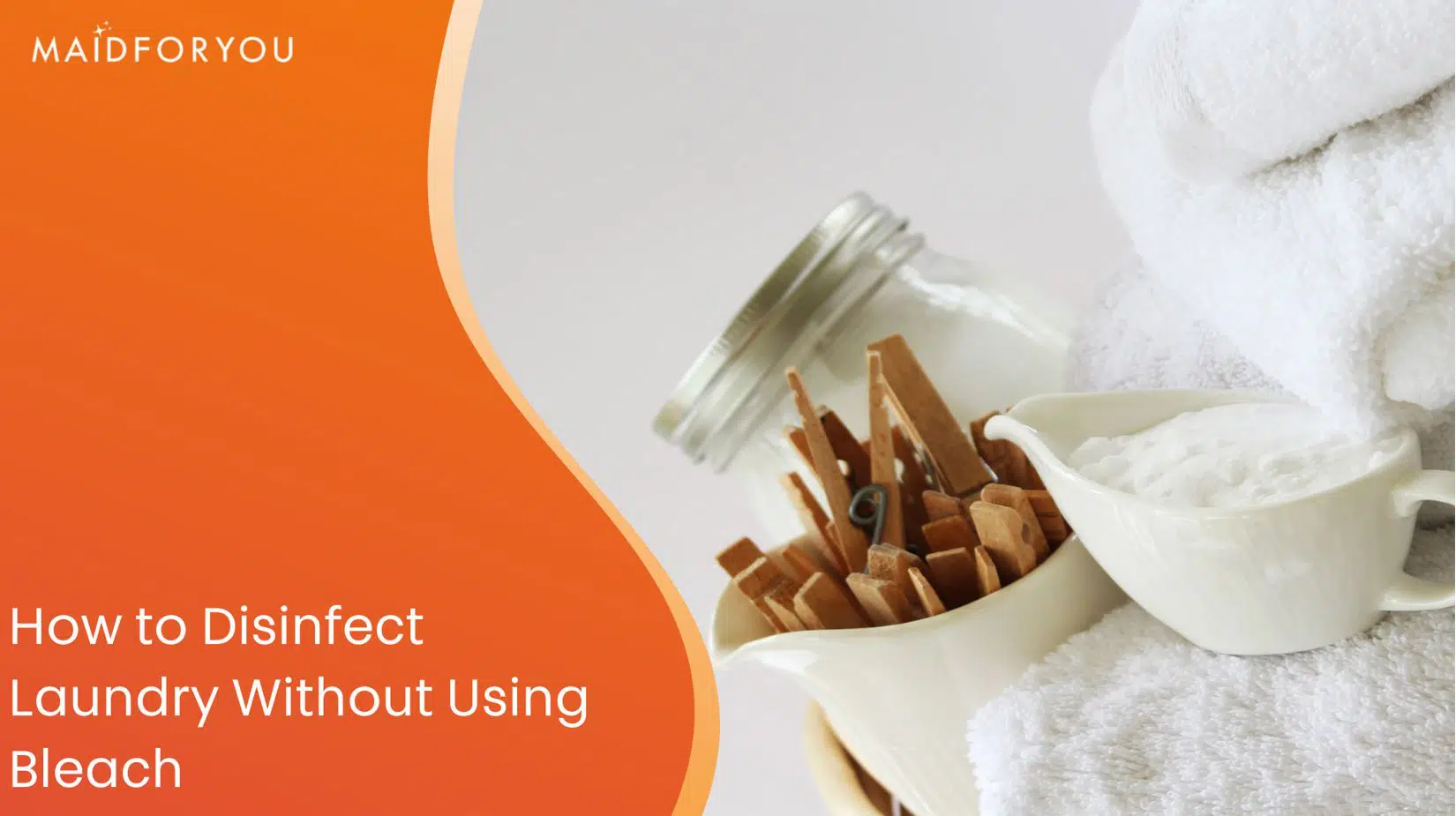




In today’s world, it is more important than ever to keep our clothes clean and free from germs and bacteria. While bleach has long been a go-to for disinfecting fabrics, it can be harsh on the skin and the environment. Thankfully, there are non-toxic methods for sanitizing clothes that are just as effective.
One of the easiest ways to disinfect clothes without bleach is to use hot water and detergent. Washing clothes in hot water, preferably above 60 degrees Celsius, can kill most germs and bacteria without the need for harsh chemicals. Adding a quality detergent to the wash can help to break down oils and dirt, ensuring a thorough clean.
Another non-toxic method for sanitizing fabrics is through the use of vinegar. Vinegar is a natural disinfectant and can kill many types of bacteria. Simply add a cup of white vinegar to your washing machine’s rinse cycle to kill any remaining germs and bacteria while leaving your clothes smelling fresh and clean.
If you’re dealing with items that can’t be washed, such as delicate fabrics or items that are dry clean only, using a steam cleaner is a great option. Steam cleaning uses high-temperature steam to kill germs and bacteria without the need for harsh chemicals. Simply pass the steam cleaner over the surface of the fabric, paying attention to any areas that may be particularly dirty or prone to bacteria buildup.
Why Use Non-Toxic Methods for Sanitizing Fabrics?
When it comes to sanitizing fabrics, many people automatically turn to bleach as their go-to solution. However, bleach contains harsh chemicals that can be harmful to both the environment and our health. Non-toxic methods for sanitizing fabrics offer a safer and more sustainable alternative.
Health Benefits
Using non-toxic methods to disinfect clothes is better for our health. Bleach and other chemical disinfectants can release harmful fumes that can irritate the eyes, nose, and throat. Long-term exposure to these chemicals may also have negative effects on our respiratory system. By opting for non-toxic methods, we can reduce the risk of these health issues and create a healthier living environment for ourselves and our families.
Environmental Benefits
Bleach and other chemical disinfectants can be damaging to the environment. When these chemicals are washed down the drain, they can contaminate water sources and harm aquatic life. Additionally, the production and transportation of bleach contribute to carbon emissions and other forms of pollution. Non-toxic methods for sanitizing fabrics, on the other hand, are more environmentally friendly and sustainable.
Safer for Fabrics
Using bleach on certain fabrics can cause discoloration or even damage them permanently. Non-toxic methods, such as using hot water or steam, are gentler on fabrics and less likely to cause any harm. This means we can effectively sanitize our clothes without worrying about ruining them in the process.
Cost-effective
Non-toxic methods for sanitizing fabrics are often more cost-effective than using bleach. Bleach can be expensive, especially if frequently used. Non-toxic alternatives, such as vinegar or baking soda, are readily available and affordable. They can effectively disinfect fabrics without breaking the bank.
Versatility
Non-toxic methods for sanitizing fabrics offer versatility. While bleach is primarily effective against bacteria and viruses, non-toxic alternatives can tackle a wider range of germs, including fungi and mildew. This makes them suitable for various fabric items, such as bedding, towels, and clothing.
Overall, using non-toxic methods for sanitizing fabrics provides numerous benefits, including improved health and safety, environmental friendliness, fabric protection, cost savings, and versatility. It’s a win-win situation for both us and the planet.
Harmful Effects of Bleach on Clothes and Health
- Bleach can cause damage to clothes and fabrics.
- It can weaken the fibers in the fabric, leading to tears and holes.
- Bleach can also cause colors to fade or change, making clothes look dull and worn.
- Repeated use of bleach on clothes can result in thinning and degradation of the fabric.
- In some cases, bleach can even cause fabric to become brittle and break.
Bleach can also have harmful effects on health:
- When bleach is used in poorly ventilated areas, it can release toxic fumes that can irritate the respiratory system and cause breathing difficulties.
- Exposure to bleach fumes can also lead to symptoms such as coughing, wheezing, and chest tightness.
- Bleach can cause skin and eye irritation, and prolonged contact can result in burns.
- Ingesting or swallowing bleach can be extremely dangerous and can lead to poisoning. It can cause severe burns in the mouth, throat, and stomach.
- Exposure to bleach has been associated with an increased risk of respiratory problems, including asthma and other lung diseases.
It is important to handle bleach with caution and take proper safety measures when using it. Alternatives to bleach should be considered for both fabric disinfection and personal health.
Natural Alternatives to Bleach for Disinfecting Clothes
While bleach is commonly used to disinfect clothes, it can be harsh on fabrics and may not be suitable for everyone, especially those with sensitive skin or allergies. Fortunately, there are natural alternatives to bleach that are effective at killing germs and sanitizing fabrics.
1. White Vinegar

White vinegar is a versatile cleaning agent that can also be used to disinfect clothes. Add half a cup of white vinegar to your laundry along with your regular detergent. The acetic acid in vinegar helps kill bacteria, viruses, and molds.
2. Essential Oils
Essential oils like tea tree oil, lavender oil, and eucalyptus oil have natural antiseptic properties. Add a few drops of your preferred essential oil to your laundry detergent or fabric softener to help disinfect and freshen your clothes.
3. Hydrogen Peroxide
Hydrogen peroxide is a natural disinfectant that can be used to kill germs on clothes. Use a 3% hydrogen peroxide solution and add half a cup to your laundry. It can help remove stains and eliminate odor-causing bacteria.
4. Baking Soda
Baking soda is a natural deodorizer and can also help disinfect clothes. Add half a cup of baking soda to your laundry along with your regular detergent. It can help neutralize odors and kill some bacteria and fungi.
5. Sunlight
Sunlight has natural bactericidal properties, and hanging your clothes out to dry in the sun can help disinfect them. Ultraviolet (UV) rays from the sun can kill bacteria and viruses. Make sure to turn your clothes inside out to protect the color from fading.
6. Steam
Steam can effectively kill germs on clothes without the use of any chemicals. You can use a garment steamer or hold your clothes over a pot of boiling water to expose them to steam. This method can also help eliminate wrinkles.
7. Washing at High Temperatures
Washing your clothes at high temperatures can help kill germs and disinfect them effectively. Use the hottest water recommended for your fabric and check the care instructions on your clothes to ensure they can withstand high temperatures.
Remember, always follow the care instructions on your clothes and test any natural disinfectant on a small, inconspicuous area before applying it to the entire garment to avoid any potential damage.
Vinegar: A Powerful Disinfectant for Fabrics
Vinegar is a versatile and effective disinfectant that can be used to kill bacteria, viruses, and other germs on various surfaces, including fabrics. It is non-toxic, environmentally friendly, and inexpensive, making it a popular choice for sanitizing clothes.
How does vinegar disinfect fabrics?
Vinegar contains acetic acid, which has antibacterial and antiviral properties. When applied to fabrics, it can help to kill germs and deodorize them. However, it is important to note that vinegar is not a registered disinfectant and may not be as effective as commercial disinfectants or bleach. It is best suited for general cleaning and sanitization purposes.
How to use vinegar to disinfect clothes?
To disinfect clothes with vinegar, follow these steps:
- Fill a sink or basin with warm water.
- Add one cup of white vinegar to the water.
- Submerge the clothes in the mixture and agitate them to ensure they are fully soaked.
- Allow the clothes to soak for at least 30 minutes.
- After soaking, wash the clothes as usual with laundry detergent.
- Air dry the clothes or use a dryer if the fabric allows.
Precautions to take when using vinegar:
- Avoid using vinegar on delicate fabrics: Vinegar is acidic and may damage delicate fabrics such as silk or wool. It is best to test a small, inconspicuous area of the fabric before using vinegar on the entire garment.
- Do not mix vinegar with bleach: Mixing vinegar with bleach can create toxic fumes. It is important to choose one disinfectant and use it separately.
- Consider using vinegar as a pre-soak: For heavily soiled clothes or those with strong odors, you can pre-soak them in a mixture of water and vinegar before washing. This can help to remove stains and odors more effectively.
Additional benefits of using vinegar:
In addition to its disinfecting properties, vinegar can provide other benefits when used on fabrics:
- Neutralizing odors: Vinegar can help to eliminate unpleasant odors from clothes, such as sweat or smoke.
- Removing stains: Vinegar can be effective in removing stains from fabrics, especially those caused by coffee, tea, or deodorant.
- Softening fabrics: Adding vinegar to the rinse cycle of the washing machine can help to soften fabrics naturally and reduce static cling.
In conclusion, vinegar is a powerful and versatile disinfectant that can be used to sanitize clothes. It is a safe and eco-friendly alternative to chemical-based disinfectants, although it may not be as effective against certain types of germs. With proper precautions and usage, vinegar can be a valuable tool in keeping fabrics clean and germ-free.
Hydrogen Peroxide: Effective for Killing Germs

Hydrogen peroxide is a powerful and effective disinfectant that can be used to kill germs on fabrics. It is an oxidizing agent that can break down into water and oxygen, making it safe for the environment and non-toxic for humans.
Using Hydrogen Peroxide to Disinfect Clothes
To use hydrogen peroxide to disinfect clothes, follow these steps:
- Gather the necessary supplies: You will need hydrogen peroxide (3% concentration), a spray bottle, and clean water.
- Dilute the hydrogen peroxide: Mix one part hydrogen peroxide with two parts water in the spray bottle.
- Spray the solution on the fabric: Spray the diluted hydrogen peroxide solution directly onto the fabric, focusing on the areas that need disinfection.
- Allow it to sit: Let the solution sit on the fabric for at least 5 minutes to effectively kill the germs.
- Rinse with water: Rinse the fabric thoroughly with clean water to remove any residue.
- Dry the fabric: Allow the fabric to air dry or follow the washing instructions for the specific fabric.
Advantages of Using Hydrogen Peroxide
- Non-toxic: Hydrogen peroxide is a non-toxic alternative to bleach, making it safe for use around children and pets.
- Environmentally friendly: It breaks down into water and oxygen, leaving no harmful chemicals behind.
- Efficient: Hydrogen peroxide is effective at killing a wide range of germs, including bacteria, viruses, and fungi.
- Cost-effective: It is an affordable option for disinfecting clothes.
Precautions when Using Hydrogen Peroxide
While hydrogen peroxide is generally safe to use, it is important to take some precautions:
- Test on a small area: Before applying hydrogen peroxide to a large area of fabric, test it on a small, inconspicuous spot to ensure that it does not cause any discoloration or damage.
- Protect your skin: Use gloves when handling hydrogen peroxide to avoid skin irritation.
- Store properly: Keep hydrogen peroxide in a cool, dark place, away from direct sunlight and heat sources.
- Follow instructions: Always follow the instructions on the hydrogen peroxide bottle for best results.
Conclusion
Hydrogen peroxide is an effective and non-toxic method for disinfecting clothes. It is easy to use, environmentally friendly, and can kill a wide range of germs. By following the proper precautions, you can safely sanitize your fabrics without the need for bleach.
Essential Oils: Natural Antimicrobial Agents
Essential oils are highly concentrated plant extracts that have been used for centuries for their medicinal and therapeutic properties. Many essential oils have antimicrobial properties, making them effective natural alternatives to chemical disinfectants. Here are some essential oils that can be used to sanitize and disinfect clothes:
Tea Tree Oil
Tea tree oil is a potent antimicrobial agent that can kill a wide range of bacteria and fungi. It is particularly effective against staphylococcus aureus and candida albicans, two common pathogens that can cause infections and odors in clothes. To use tea tree oil as a disinfectant, add a few drops to your laundry detergent or dilute it in water and spray it on your clothes before washing.
Lavender Oil
Lavender oil is known for its calming aroma, but it also has powerful antimicrobial properties. It can help kill bacteria, fungi, and viruses, making it an effective natural disinfectant for clothes. To use lavender oil, add a few drops to your laundry detergent or mix it with water and spray it on your clothes before washing.
Peppermint Oil
Peppermint oil contains menthol, which has antimicrobial properties. It can help kill bacteria and fungi, and its refreshing scent can also help mask any odors on your clothes. To use peppermint oil, add a few drops to your laundry detergent or mix it with water and spray it on your clothes before washing.
Eucalyptus Oil
Eucalyptus oil has a strong, fresh aroma and powerful antimicrobial properties. It can help kill bacteria, viruses, and fungi, making it an excellent natural disinfectant for clothes. To use eucalyptus oil, add a few drops to your laundry detergent or mix it with water and spray it on your clothes before washing.
How to Use Essential Oils to Disinfect Clothes
Here are a few methods for using essential oils to sanitize and disinfect your clothes:
- Add a few drops of your chosen essential oil to your laundry detergent before washing your clothes.
- Mix a few drops of essential oil with water in a spray bottle and spray it on your clothes before washing.
- Make a fabric softener by adding a few drops of essential oil to a small amount of white vinegar, then add it to the rinse cycle of your laundry.
- For specific stains or odors, apply a small amount of essential oil directly to the affected area before washing.
Remember to always dilute essential oils before using them directly on your clothes to avoid staining or skin irritation. Additionally, it’s a good idea to do a patch test on a small, inconspicuous area of fabric before using any essential oil on your clothes.
By incorporating essential oils into your laundry routine, you can effectively sanitize and disinfect your clothes without the use of bleach or other harsh chemicals. Plus, you’ll enjoy the added benefits of a fresh, natural scent!
Steps to Disinfect Clothes Using Non-Toxic Methods
1. Washing Machine Method
- Sort your clothes based on color and fabric type.
- Place the clothes in your washing machine.
- Add the recommended amount of non-toxic laundry detergent.
- Select the appropriate wash cycle and water temperature for your clothes.
- Start the washing machine and let it run its cycle.
- Transfer the clothes to the dryer, or hang them to air dry.
2. Vinegar Soak Method
- Fill a basin or sink with warm water.
- Add 1 cup of white vinegar for every gallon of water used.
- Submerge the clothes in the vinegar solution and let them soak for 30 minutes.
- After soaking, drain the water and rinse the clothes with clean water.
- Squeeze out the excess water and hang the clothes to dry.
3. Steam Method
- Hang the clothes on a hanger or place them on a clothes rack.
- Using a handheld garment steamer, pass the steamer over the clothes, ensuring that steam penetrates all areas.
- Focus on high-touch areas such as collars, cuffs, and armpits to ensure thorough disinfection.
- Allow the clothes to dry completely before storing or wearing.
4. Sunlight Method

- Choose a sunny spot outdoors or near a window where the clothes can be exposed to direct sunlight.
- Hang the clothes on a clothesline or lay them flat on a clean surface.
- Leave the clothes in the sunlight for at least 6 hours to allow UV rays to disinfect them.
- Make sure to sun both sides of the clothes for maximum disinfection.
5. Ironing Method
- Set your iron to the appropriate temperature for the fabric of your clothes.
- Iron each garment, paying attention to seams, collars, and cuffs.
- Hold the iron on each area for at least 30 seconds to ensure proper disinfection.
- Make sure the iron is clean to avoid transferring any dirt or bacteria onto the clothes.
Remember, it’s important to follow the care instructions on your clothes to avoid damaging them during the disinfection process. These non-toxic methods are effective alternatives to using bleach and can help keep your clothes clean and germ-free.
FAQ
How can I disinfect clothes without using bleach?
There are several non-toxic methods to sanitize fabrics without using bleach. You can use hot water and detergent, steam, vinegar, baking soda, or hydrogen peroxide. Each of these methods effectively kills bacteria, viruses, and other germs on clothes.
Does hot water and detergent kill germs on clothes?
Yes, using hot water and detergent is a great way to kill germs on clothes. The hot water helps to kill bacteria, viruses, and other germs, while the detergent helps to remove dirt and stains. Make sure to use the highest water temperature that is safe for the fabric.
Can vinegar be used to disinfect clothes?
Yes, vinegar is an effective and non-toxic method for sanitizing fabrics. It has antimicrobial properties that can kill bacteria, viruses, and other germs. You can add half a cup of vinegar to your laundry cycle or use it as a pre-soak before washing.
How does steam help in disinfecting clothes?
Steam can effectively kill bacteria, viruses, and other germs on clothes. The high temperature of steam helps to destroy the proteins and enzymes that bacteria and viruses need to survive. You can use a garment steamer or an iron with a steaming function to sanitize your clothes.
Is hydrogen peroxide a safe and effective method to disinfect clothes?
Yes, hydrogen peroxide is a safe and effective method for sanitizing fabrics. It has strong antimicrobial properties and can kill bacteria, viruses, and other germs. You can add half a cup of hydrogen peroxide to your laundry cycle or use it as a pre-soak before washing.
What are some non-toxic methods for disinfecting clothes?
There are several non-toxic methods for disinfecting clothes. One option is to use white vinegar, which is known for its antibacterial properties. You can add half a cup of white vinegar to your laundry load to kill bacteria and germs. Another option is to use hydrogen peroxide, which can be added to your laundry along with your regular detergent. Additionally, essential oils like tea tree oil and lavender oil have natural disinfecting properties and can be added to your laundry as well.












